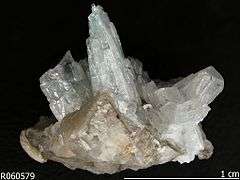Kovdorskite
| Kovdorskite | |
|---|---|
|
Photograph of kovdorskite from Kovdor Massif, Kola Peninsula, Murmanskaja Oblast', Northern Region, Russia. | |
| General | |
| Category | Phosphate minerals |
| Formula (repeating unit) | Mg2PO4(OH)·3H2O |
| Strunz classification | 8.DC.22 |
| Dana classification | 43.05.08.01 |
| Crystal system | Monoclinic |
| Crystal class |
Prismatic (2/m) H-M symbol: (2/m) |
| Space group | P21/n |
| Unit cell |
a = 10.35, b = 12.90 c = 4.73 [Å]; Z = 4 |
| Identification | |
| Color | Translucent white to pale blue to bright pink |
| Crystal habit | Rough prismatic |
| Fracture | Conchoidal to uneven |
| Mohs scale hardness | 4 |
| Luster | Vitreous |
| Specific gravity | 2.28 (measured), 2.30 (calculated) |
| Optical properties | Biaxial (-) |
| Refractive index | nα = 1.527 nβ = 1.542 nγ = 1.549 |
| Birefringence | δ = 0.022 |
| 2V angle | 80°-82° (measured) |
| Dispersion | r > v, very weak |
| References | [1][2][3][4] |
Kovdorskite, Mg2PO4(OH)·3H2O, is a rare, hydrated, magnesium phosphate mineral. It was first described by Kapustin et al.,[5] and is found only in the Kovdor Massif near Kovdor, Kola Peninsula, Russia.[3] It is associated with collinsite, magnesite, dolomite, hydrotalcite, apatite, magnetite, and forsterite.[1]
References
- 1 2 Anthony J W, Bideaux R A, Bladh K W, and Nichols M C (1990) Handbook of Mineralogy, Mineral Data Publishing, Tucson Arizona, USA, by permission of the Mineralogical Society of America .
- ↑ Ovchinnikov V E, Soloveva L P, Pudovkina Z V, Kapustin Y L, Belov N V (1980) The crystal structure of kovdorskite Mg2(PO4)(OH)·3(H2O), Doklady Akademii Nauk SSSR, 255, 351-354 .
- 1 2 Kovdorskite on Mindat.org
- ↑ Kovdorskite data on Webmineral
- ↑ Kapustin, Y. L., Bykova, A. V. & Pudovkina, Z. V. (1980). Zap. Vses. Mineral. Ova. 109, 341-347
Further reading
- Subbotin, R. P. L. V. V., & Pakhomovsky, Y. A. (1998). A new type of scandium mineralization in phoscorites and carbonatites of the Kovdor massif, Russia. Canadian Mineralogist 36:971-980.
- Yakovenchuk V N, Ivanyuk G Y, Mikhailova Y A, Selivanova E A, Krivovichev S V (2006) Pakhomovskyite, Co3(PO4)2·8H2O, a new mineral species from Kovdor, Kola Peninsula, Russia, The Canadian Mineralogist 44, 117-123
This article is issued from Wikipedia - version of the 11/19/2016. The text is available under the Creative Commons Attribution/Share Alike but additional terms may apply for the media files.
